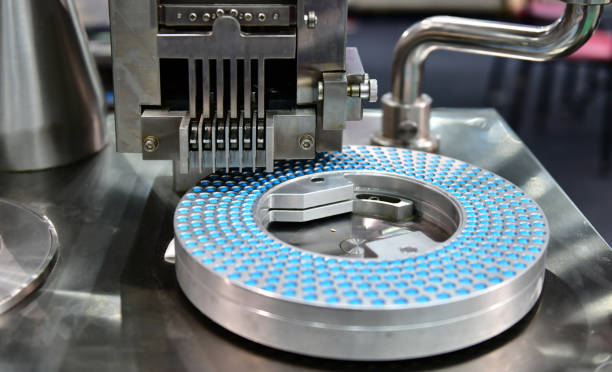Pharmaceutical company improves OEE by 10% in 6 months by achieving maintenance excellence





Coaxing a 20th-century Factory into the new Millennium
The customer is an established and respected manufacturer of metal-mesh personal safety equipment especially for the food processing industry. The plant – highly innovative in the 1960s and upgraded with the most modern electronic controllers available in the 1980s – is starting to show the weaknesses of its age: although the machinery still works smoothly, the electronic components are woefully out-of-date: replacement parts are no longer easily obtainable, so malfunctions can result in stoppages of unforeseeable duration.
The 60 or so machines specialized for the various products and stages of manufacture are all bespoke, designed and built by the company itself to perform exactly the tasks necessary, and they still manage to do that well: product quality is excellent, overall productivity acceptable. The equipment is operated by just a handful of highly skilled employees, who are responsible for both the running and the upkeep of their machines: they know them inside and out, so they can even fabricate mechanical parts when replacements are needed. But the electronics that control the automation are from a bygone era. Starting up a production batch involves flashing a memory card with the process instructions and walking it over to a controller box mounted onto the equipment, where it is slotted in by hand. The procedure has been repeated for each new run, several times a day – for the last 30 years.
The resulting physical wear and tear on the plug contacts and electrodes, combined with the damaging effects of the production environment (dust and grease, vibrations, static), make these control units highly susceptible to crashes. Not to mention the risk of common operator errors, like mixing up the memory cards. Plus, the information available on the tiny output screens is minimal: there’s too little data on what’s happening to take strategic interventions if a station starts overheating, for example, or if the process being performed drifts out of tolerance. And it’s almost impossible to optimize the process.
Replacing the outmoded electronics without changing the machinery it drives requires a whole new engineering strategy – one that not only solves the immediate problem (maintenance difficulties, risk of downtime) but also gives this still-productive factory a new lease on life.
According to the principles of Industry 4.0, the great potential of modern manufacturing involves much more than just improved automation techniques: it lies in evaluating the data from all the aspects of a given process. Sensor data – not only the measurements taken on the products being made but also coming from the machine itself – are communicated to a centralized control system, where they can be analyzed in near real-time. This allows optimization of manufacturing processes to avoid waste and scrap, to ensure quality standards and repeatability, as well as to take pre- programmed and automatic actions based on real-time process conditions. At the same time, operational data can be used for predictive maintenance of the equipment by monitoring signals that indicate when a breakdown or degradation in performance is imminent, instead of simply replacing parts according to an arbitrary schedule: this balances plant uptime with safety and cost.
However, without full networking between the production line components, this longed-for added value remains stubbornly out of reach. But what SME is prepared to toss everything out the window and start from scratch, especially when the process has worked so well for decades? That means:
while it may not be possible to achieve everything in one go, any steps undertaken to solve the immediate maintenance problem must also contribute to this future vision.
The customer’s forward-looking R&D department turned to The Positive Thinking Company for a solution. On their wish-list besides fewer breakdowns and better management of maintenance: a prediction environment, a central data management system, the ability to optimize the manufacturing processes. Also, information on the equipment’s usage, availability, operating efficiency. And connecting all the machines wirelessly to a centralized control system with an intuitive human-machine interface (HMI). A bigger digital output screen, more sensor data visible. More ports for more sensors! How about contactless memory cards?
In short, they wanted a sustainable, evolvable solution that’s IoT-ready, expandable and poised to take advantage of the power of their data. Oh, and please make it implementable in stages!
Responding to the customer’s desire to take a measured approach, the Positive Thinking Company’s solution foresaw a longer event horizon for the engineering change, beginning with replacement of the panel-mounted control units and interface. This gains the company a 10 to15- year window of reliable equipment operation – without the threat of irreparable component failure halting production – while a more comprehensive IoT strategy is fleshed out further.
First step: monitoring every signal coming from the production machinery while in use, in order to set a baseline for everything to follow. Next, the design and construction of a prototype programmable logic controller (PLC) – using the same wiring and connectors (plug and play) – to test on an actual machine. Finally, replacement of the old control units with the new, custom-built PLCs to outfit the machines with real computing power and embedded logic.
Rugged and easily programmable, PLCs are an established solution for reliable automation control in harsh industrial environments. Plus, they’re suited for handling several times the number of sensors as previously installed, so more types of sensor data are available for programming in automatic corrective actions when values exceed pre-set limits. Furthermore, the larger display shows considerably more production information, so a technician can monitor dynamic sensor data on both product and machine performance – and take manual interventions, if necessary. The PLCs also provide a solid basis for integration into a supervisory control and data acquisition (SCADA) system in a future, as-yet-unplanned modernization step, for example.
The team-based approach to solution development taps into the knowledge and experience of the company’s machine operators, to ensure that the solution is sustainable, and the plant continues to meet its production goals. With the groundwork thus laid for the new IoT ecosystem, every subsequent upgrade feeds into the future vision of a centralized control system.
All this saves the company maintenance costs and alleviates the incalculable risk of downtime. Furthermore, since the solution is compatible with currently installed technology, the manufacturer benefits from continued use of its legacy machinery while positioning it for future improvements in performance and operational efficiency. Truly a new lease on life for a legacy factory!